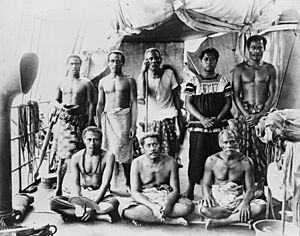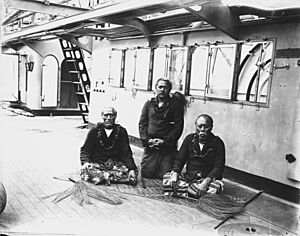Lauaki Namulauulu Mamoe facts for kids
Lauaki Namulau'ulu Mamoe (died 14 December 1915) was an important chief and speaker from Samoa. He was also known as Lauati. Lauaki was the first leader of the Mau. This was a group that resisted foreign rule in Samoa during the time of colonialism. Colonialism means when one country takes control of another.
Lauaki was from Safotulafai, which is the main village of the Fa'asaleleaga district on Savai'i island. He held two important chiefly titles: Namulau'ulu from Safotulafai and Lauaki from Tonga. He was the first in his family to hold both these titles. In 1909, Lauaki was sent away from Samoa to Saipan. He passed away in 1915 while being brought back home.
The Mau a Pule Movement

Lauaki led a resistance group on Savai'i island called Mau a Pule. This movement started in 1908. It later grew into the larger national Mau movement. The Mau a Pule was made up of chiefs who were unhappy. They felt they were losing their traditional Samoan power under the German colonial government. The German Governor at the time was Wilhelm Solf.
The Mau a Pule wanted to keep Samoan traditions strong. They used Samoan ways to organize their protests. Lauaki relied on the important chiefs of Savai'i to gather support for the Mau a Pule.
Pule is a traditional name for the chiefs from the big island of Savai'i. These chiefs were connected to the Malietoa royal family. Lauaki Namulau'ulu was a high-ranking speaker for the Pule chiefs. He spoke for them when important decisions were made for Samoa.
Samoa had two main groups of traditional leaders: Pule and Tumua. Tumua were the main chiefs from Upolu island. They supported the royal families called Tama Aiga. Upolu is the second largest island in Samoa. These two powerful groups of chiefs often competed. This competition shaped Samoa's traditional political system.
Lauaki and his followers did not want to give up their power to a foreign country. They believed that Samoa's traditional way of life was very important. This system had been built over thousands of years. It was based on history, culture, and achievements. Lauaki felt it was wrong for Samoans to lose their own way of life. Other Samoan chiefs, like Mata'afa Iosefo, also fought against foreign interference.
Exile to Saipan
In early 1909, Governor Solf decided to stop Lauaki and the Mau a Pule. He called in the military. Four warships and troops from the East Asia Squadron arrived. The warships surrounded Savai'i, separating it from Upolu.
On April 1, 1909, Lauaki and other chiefs from Safotulafai surrendered. Many Mau a Pule supporters also gave up. They were all arrested and put on trial.
On April 19, 1909, Lauaki and 71 members of the Mau a Pule were sent away. They were exiled to Saipan, which was a German colony in the Mariana Islands. They traveled on a ship called the SMS Jaguar. Other leaders who were exiled included I'iga Pisa, Asiata Tautoloa, Leiataua Mana, Namulauulu Pulali, and Tuilagi Letasi.
Some women and children were also exiled. This included Lauaki's wife, Sivaotele, and their only child, Tivoli. Lauaki never returned to Samoa. Many of those who were exiled died while they were away. Years later, some of the exiles were able to come back to Samoa. Lauaki's younger brother also died in Saipan.
Some exiles returned to Samoa, bringing back the bones of those who had died. However, Lauaki became very sick. He had to stop with his family on Tarawa island in the Gilbert Islands. Lauaki Namulau'ulu is remembered as one of the first Samoans to show strong national pride and loyalty for his country.
Lauaki's Death
On January 15, 1916, Lauaki's wife, Sivaotele, and their son arrived back in Samoa. They came on a ship called the Atua. They brought the sad news that Lauaki had died. He passed away at 10 PM on December 14, 1915, on Tarawa island.
Lauaki's Legacy
After Lauaki's death, the Mau movement continued to grow. By the late 1920s, it had a lot of support across Samoa. One of the Mau leaders in the 1920s was Olaf Frederick Nelson. He was a merchant born in Safune to a Samoan mother and a Swedish father. Nelson was also exiled from Samoa for his role in the movement.
Samoa finally gained its political independence in 1962. Lauaki's early efforts helped pave the way for this important event.




